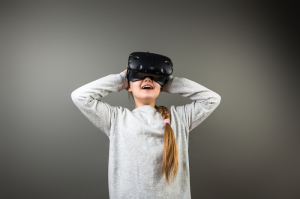From the September 2017 issue of HealthCare Business News magazine
By John Vartanian
Recent years have seen tremendous growth in the use of virtual reality in health care.
Although its uses are beneficial for patients across the life span, virtual reality is particularly effective with children and young adults.
Virtual reality (VR) is a state-of-the-art system that creates a 3-D, computer-generated environment, allowing users to be transported out of their current environment and into an entirely new “virtual” world. This goes far beyond a simple handheld video game. It is an advanced system that uses a combination of cutting-edge technologies to create a realistic, interactive experience for the user.
Goggles, known as optical head-mounted displays (OHMDs), along with specialized software, deliver high-resolution sights and sounds that provide users with an “immersive experience.” Patients can tour space, swim with whales, play soccer, bowl, visit the beach, or walk around a zoo. The devices are controlled by joy sticks, rumble pads, head movements or even the user’s breath. Apps can be downloaded and used on smartphones in conjunction with the OHMDs.
In the context of pediatric health care, VR is becoming an effective, drug-free supplement for some common childhood medical conditions. It is an ideal tool in the medical toolbox for children, who are experienced in and attracted to video games and devices. Researchers posit that the mesmerizing 3-D sights and sounds of VR provide “virtual distraction,” taking over the patients’ visual and auditory senses to the point that pain, discomfort or anxiety are reduced or even eliminated. Basically, kids are so distracted that they forget what is going on around them. Physicians at several hospitals with pilot programs note that VR gives patients positive experiences in miserable situations, improving their moods and allowing them to be kids again and just have fun.
The typical kid hates shots, but for many, shots are part of their weekly or daily medical regimen. Examples include chemotherapy, IVs, drawing blood and infusions for hemophilia. Even vaccinations can induce fear in young patients. Because their arms must be free for these procedures, VR can be experienced using head movements and breath. By engrossing these children in a virtual world, VR calms them down, easing their anxiety and distracting them such that they cooperate better with caregivers. The process is then faster, easier and more pleasant for everyone. Additional benefits include less parental distress and less staff time, thereby resulting in reduced costs for the hospital.
